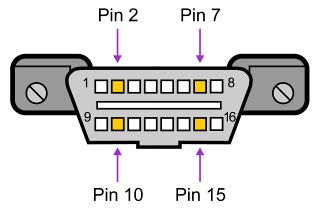
2019-03-12
Which OBD-II protocol is supported by vehicle?
All cars and light trucks built for sale in the United States after 1996 are required to be OBDII compliant. The European Union adopted a similar law in 2000 for gasoline-powered vehicles, and in 2003 for cars with diesel engines.
An OBD-II compliant vehicle can use any of the five communication protocols: J1850 PWM and VPW, ISO9141, ISO14230 (also known as Keyword Protocol 2000), and more recently, CAN (ISO15765/SAE J2480). Car manufacturers were not allowed to use CAN until model year 2003.
As a general rule, you can determine which protocol your vehicle is using by looking at the pinout of the DLC:

The following table explains how to determine the protocol:
| Pin 2 | Pin 6 | Pin 7 | Pin 7 | Pin 14 | Pin 15* | Standard |
| J1850 Bus+ | CAN High |
ISO 9141-2K Line and ISO/DIS 14230-4 |
J1850 Bus | CAN Low |
ISO 9141-2L Line and ISO/DIS 14230-4 |
- |
| must have | - | - | must have | - | - | J1850 PWM |
| must have | - | - | - | - | - | J1850 VPW |
| - | - | must have | - | - | may have | ISO9141/14230 |
| - | must have | - | - | must have | - | CAN |
| The connector should have: Pin 4 - Chassis Ground, Pin 5 - Signal Ground, Pin 16 - Battery power | ||||||
This means that:
| Protocol | The connector must have pins |
| PWM | 2, 4 and/or 5, 10, and 16 |
| VPW | 2, 4 and/or 5, and 16, but not 10. |
| ISO | 4 and/or 5, 7, and 16. Pin 15 *may or may not be present. |
| CAN | 4 and/or 5, 6, 14 and 16 |
*For ISO communications, pin 15 (L-line) is not always required. Pin 15 was used on earlier ISO/KWP2000 cars to "wake-up" the ECU before communication could begin on pin 7 (KLine). Later cars tend to communicate using only pin 7 (K-Line).
Because of the different protocol a car might have it is recommended to use an interface which supports all protocols as all modern interfaces do.